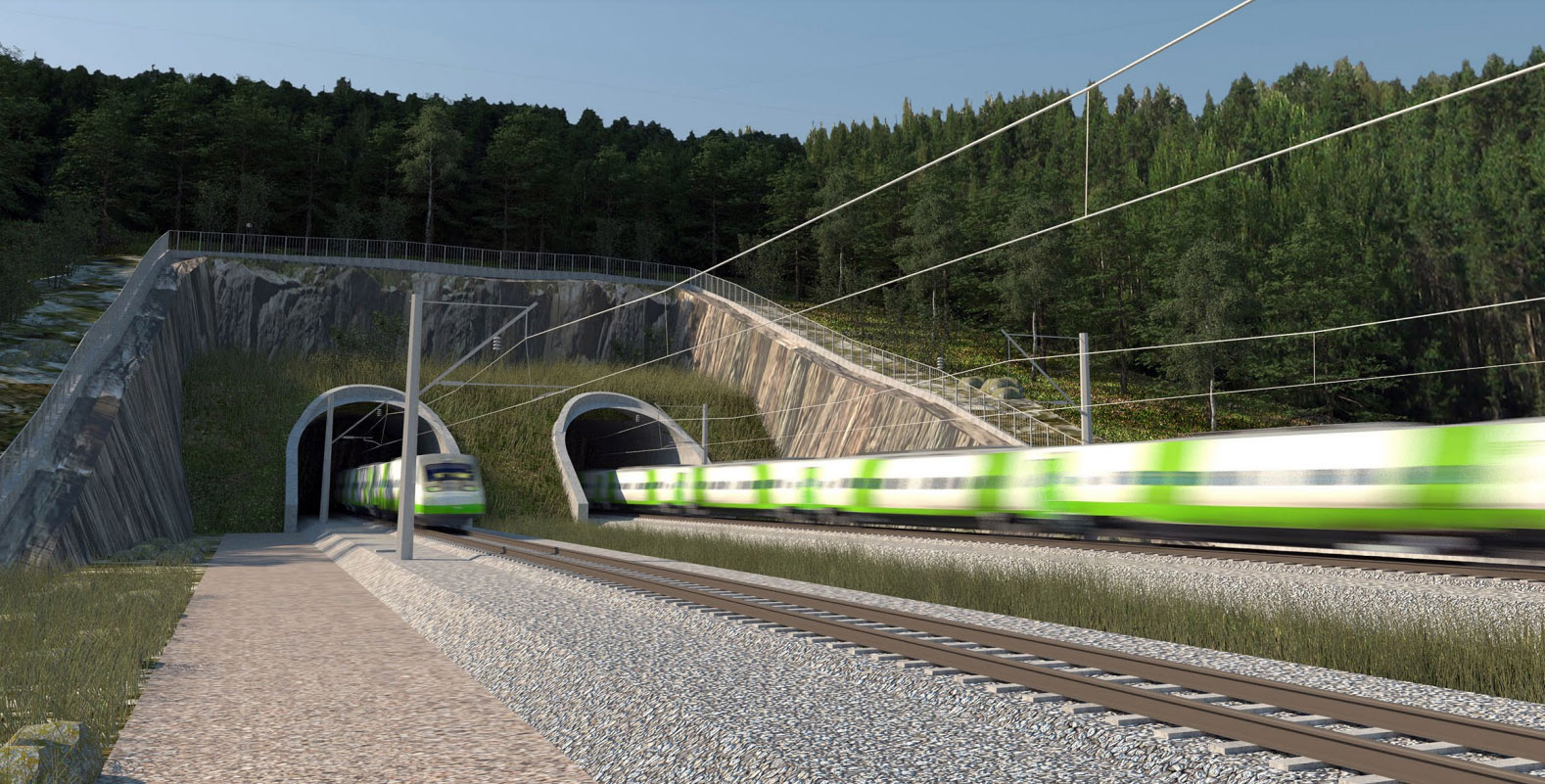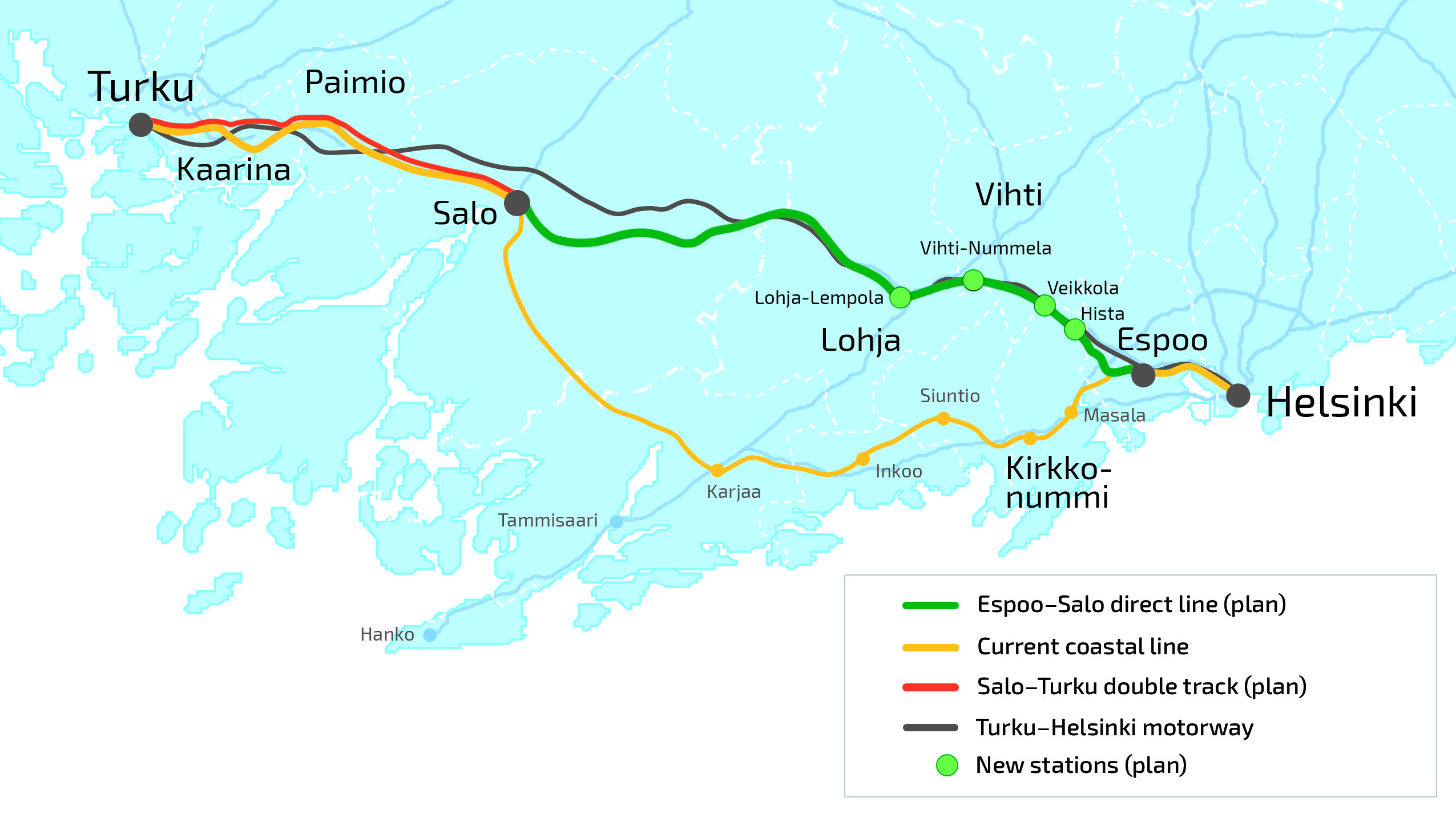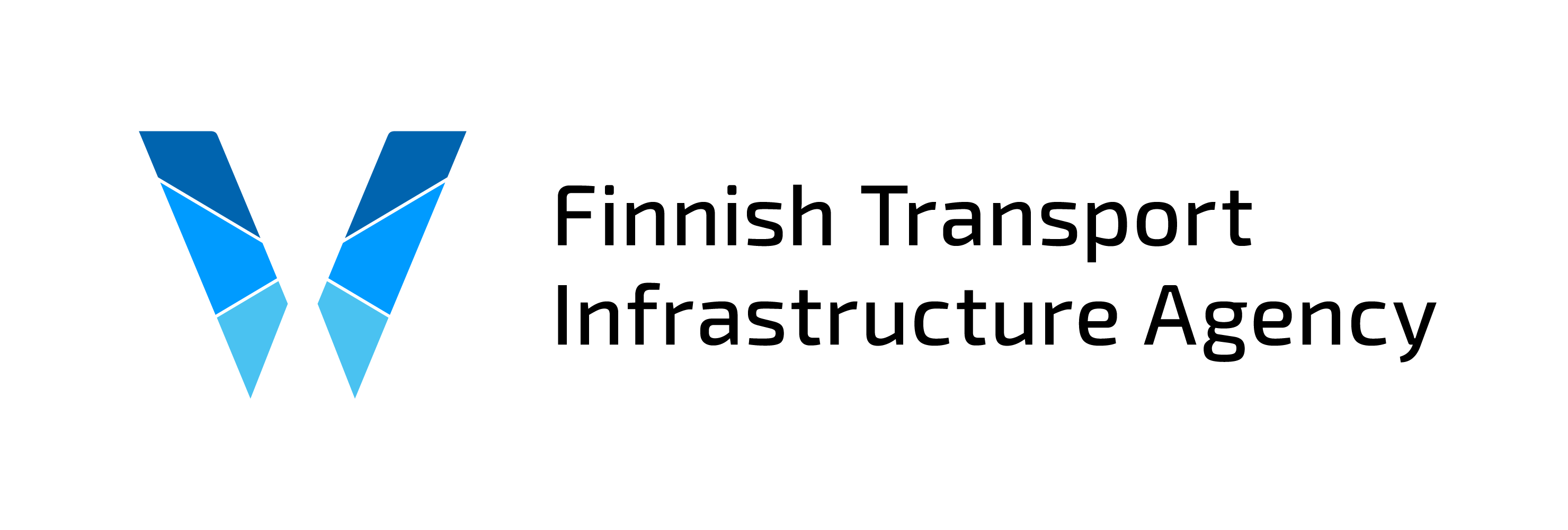General plan for Espoo-Salo railway line now available
Published 8.11.2022 10.25
A railway line is being planned between Espoo and Salo. The railway line would be part of the high-speed train connection between Helsinki and Turku.

Planning of the Espoo-Salo railway line has progressed and the general plan is now available. The general plan answers, among others, the following questions:
- Where is the new railway located?
- How will the new railway affect road and traffic conditions and road safety?
- How will the new railway affect the environment, human health and living conditions?
- How can the potential adverse effects of the project be eliminated or reduced?
- What are the basic transport and technical solutions of the studied construction alternatives?
- How much does building of the project initially cost?

Image: The planned Espoo-Salo direct line (shown in green). Click to enlarge.
About the Espoo-Salo railway line
A high-speed train connection between Helsinki and Turku is being planned. The project is also known as the "Turku One Hour Train". The project consists of four entities: Espoo City Railway, Espoo-Salo railway line, Salo-Turku double track and Turku Railyard. The now available general plan applies to the Espoo-Salo railway line. The Finnish Transport Infrastructure Agency is responsible for the general plan for the Espoo-Salo railway line.
Rail traffic between Espoo and Salo now runs along a shore track, which is complicated and long. The track was originally built over 100 years ago and requires continuous repairs. Despite the repairs, the track’s condition is so poor in places that it is harmful to train traffic.
The aim of the high-speed rail link between Helsinki and Turku and the Espoo-Salo railway line is to shorten the travel time between Helsinki and Turku. The new rail link makes it possible to speed up long-distance traffic by about half an hour and to start commuter traffic between Helsinki and Lohja. The current shore track would have the same type of commuter traffic. Benefits from the significant reduction in the travel time between Helsinki and Turku will only be obtained when the Espoo–Salo direct line is in use.
The current track is largely single-track while the new one is double-track. The railway improves the smoothness and punctuality of train traffic. Disruptions would also be easier to solve, and the allure of train traffic and number of passengers will increase.
In November 2022, the Finnish Transport Infrastructure Agency published a project evaluation of the Espoo–Salo direct line. It assesses the monetary impacts of the transport project. The benefit-cost ratio of the direct line is 0.54, which means that the investment costs of the direct line are calculated to be greater than the financial savings it brings to transport. However, the ratio falling below one does not necessarily mean that the project is unprofitable, because the benefit-cost ratio only takes into account the benefits to transport. It does not take into account all the social impacts of the project.
General plan available
The now available general plan for the Espoo-Salo railway line is based on the initial general plan for the Espoo-Salo railway line and the EIA (Environmental impact assessment). Both of these were completed in 2010. In addition, an EIA for the high-speed train connection between Helsinki and Turku was completed in 2021. It is a massive project with a lengthy planning process. The general plan has required, among other things, that the location of the track be marked in regional and local functional zoning.
The general plan proposal is available for 30 days. During this time, others interested in the project than the property owners can give their opinion on the general plan. These reminders will be taken into account in the decision.
General plan drawn up with extensive cooperation
The Finnish Transport Infrastructure Agency has drawn up the general plan in cooperation with the Regional Councils of Helsinki-Uusimaa and Southwest Finland, the ELY Centres of Uusimaa and Southwest Finland and the municipalities along the direct line, Espoo, Kirkkonummi, Vihti, Lohja and Salo. Other stakeholders include the Finnish Heritage Agency, the Espoo City Museum, the Regional museum of Southwest Finland, the Länsi-Uusimaa Rescue Department, the Southwest Finland Emergency Services and HSL.
All the above-mentioned stakeholders have been represented in the project group. In addition to these stakeholders, residents and other stakeholders have had the opportunity to participate in and comment on the planning at residents’ meetings organised a total of 15 times in different municipalities in 2018 and 2019.
Tell us what you think
Read more about the general plan: https://vayla.fi/kaikki-hankkeet/espoo-salo-oikorata (in Finnish)
Reminders must be submitted no later than 8.12.2022.
Letters concerning the subject have also been sent to the homes of the area’s property owners.
Figures on the Espoo-Salo railway line plan
- 95 kilometres of new track
- 110 new bridges
- 23 new railway tunnels
- four new stations: Espoo’s Hista, Kirkkonummi’s Veikkola, Vihti Nummela and Lohja’s Lempola
- Estimated construction costs of the project amounts to approximately EUR 2.9 billion
Project progress
In 2021, the project also started a more detailed track planning phase commissioned by the project company Turun Tunnin Juna Oy. In the track planning phase, the more precise location of the track and the areas required for the track are defined.
After a possible construction decision, a detailed construction plan must be drawn up for the project. No decision has been made on the construction of the project.
Further information
https://vayla.fi/kaikki-hankkeet/espoo-salo-oikorata
Project evaluation: https://www.doria.fi/bitstream/handle/10024/186086/vj_2022-63_978-952-405-004-3.pdf?sequence=1&isAllowed=y
Heidi Mäenpää
Project Manager
Finnish Transport Infrastructure Agency
Tel. +358 (0)29 534 3819
[email protected]
Attachments
This is an old article. It may contain deprecated information and the links may not work. Our publications can be found in the Doria publication archive
